In part 3 of our report on Salwa Mikdadi's keynote lecture at the "Arab Express" symposium we focus on the region's changing art scene, including the relationship between Arab art and conditions in surrounding countries, funding and the increasing number of galleries and museums, and biennials.
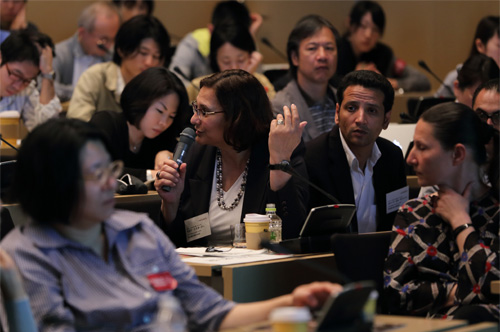
Salwa Mikdadi answering a question from the audience
Photo: Mikuriya Shinichiro
Increasing funding and the changing art scene
In the past, funding for international art was limited, thus prompting international curators to restrict exhibitions from the region to video art, which was more economical and easier to transport. However, in the last 10 years art exhibitions and biennials have expanded their outreach to include more international artists, such as Arab artists, and hence curators began conducting their own research in the region.
In the late 1990s international funding for art, particularly from European agencies, resulted in a significant increase in the number of art projects taking place and also allowed for greater distribution in Europe. For many of the Arab grassroots art organizations, foreign assistance was the only source of funding aside from the very few local institutions such as Darat al Funun in Jordan, which will be celebrating its 25th anniversary next year. In the last 12 years this nascent art scene has grown dramatically, from about 30 to 40 independent non-profit art organizations in the late 1990s to over 200 art institutions in the Arab world today. This dramatic increase is particularly evident in countries such as Morocco, Tunisia, Algeria and Egypt. These institutions are established and run by young art professionals, artists or art activists mostly under the age of 35. They reflect the dominant population of the Arab world, where 60% of the regions' population is under the age of 30. Grassroots art collectives are also a recent addition to the mix, and they are sharing resources and in some cases, insisting on operating without relying on outside funding.
Lebanon has established itself again along with Cairo as a center for 'intellectual' artistic production, while Dubai is the commercial center and Abu Dhabi, Doha and Sharjah have government-run institutions that continue to attract international crowds to their current museums and biennials. The Cairo and Sharjah Biennials, Home Works in Beirut, Assila in Morroco, as well as many film festivals have all contributed to expanding the Arab art scene by inviting international artists, curators, and museums to the region.
Another recent addition that contributed to the rise of Arab art is artist residencies. Many of the emerging Arab artists received their first international exposure at residencies, which helped advance their careers through networking and peer reviews. International artists are also frequently invited to do research, exhibit, or teach in the Arab region.
Foreign cultural centers increased their funding for art and culture in all the Arab countries. Their governments saw art as a form of "soft diplomacy."
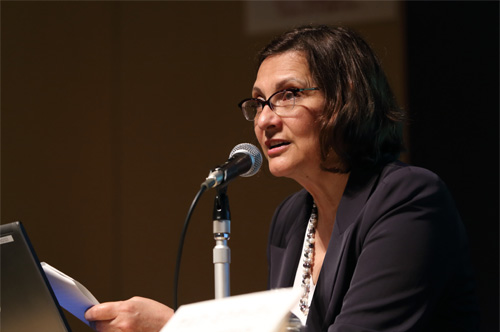
Salwa Mikdadi(Art historian specializing in modern and contemporary art of the Arab world)
Photo: Mikuriya Shinichiro
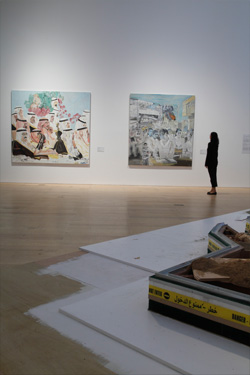
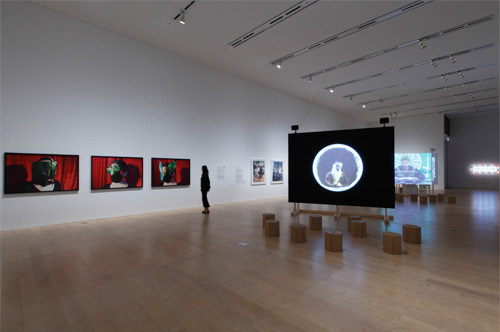
"Arab Express" installation view
Photo: Kioku Keizo
Rising prices and flourishing cultural facilities
Last but not least, the economic boom in 2003 in the Gulf attracted auction houses which established Arab art for the first time on the international market. Bonham's, then Christies and Sotheby's, shored up the prices of Arab art. Art was selling in Dubai at 10 times its price at galleries in Cairo or Beirut. There are 130 art spaces and galleries in Dubai now compared with only 3, 10 years ago. Art fairs, meanwhile, continue to flourish in Dubai, Abu Dhabi, Beirut and Marrakech. Plans for new museums in Dubai, Abu Dhabi, Doha, and now Beirut will provide a more stable and sustainable support system for art.
Sadly, education remains far behind compared to the art market. In the Gulf region, there are only 3 universities offering a final degree in art practice and none with degrees dedicated to art history.
Arab artists are now more engaged with the general public. The Arab uprisings have brought the art out from the galleries to the streets. Artists participated in the demonstrations at Tahrir Square, leading others in creating wall murals and graffiti art on walls and on the streets.
I am often asked how the Arab Spring changed art. It is too early to know the long term implications of the Arab Spring on visual art or how long artists can sustain a conversation with the public started in Tahrir Square in Cairo or Sahet al Taghyeer in Sanaa. Will taking art to the people change how art is perceived by the average Egyptian or Yemeni or Syrian?
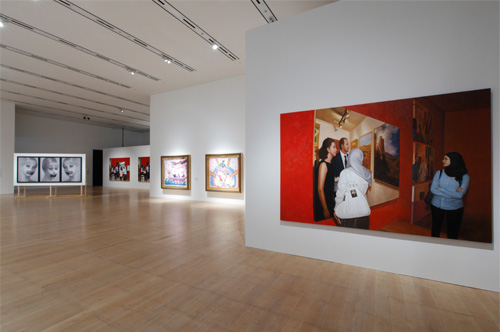
"Arab Express" installation view
Photo: Kioku Keizo
■Relevant information
・Today's Arab Art
Part 1 Arab art under the world spotlight
Part 2 Arab artists on the rise
Part 3 The future of ever-changing Arab art
Part 4 The Arab Spring and its impact on art
・Arab Express: The Latest Art from the Arab World
June 16 - October 28, 2012
・"Arab Express: The Latest Art from the Arab World" photos from installation period (flickr)
・"Arab Express: The Latest Art from the Arab World" Installation view (flickr)
Section 1
Section 2
Section 3 & "Arab Lounge"
・Interview: Nanjo Fumio on "Arab Express"
Part 1 Comparing the Arab world of the 1970s with that of today
Part 2 Why is the world fascinated with Arab contemporary art?
Part 3 An exhibition to encourage cultural diplomacy, mutual understanding
・Interview: Kondo Kenichi on "Arab Express"
Part 1 Want to show Japan the diversity of the Arab world
Part 2 Exhibition highlights: Black Fountain and "Arab Lounge"








